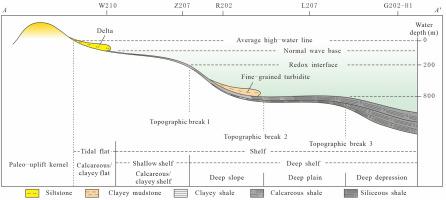A model for predicting marine shale gas sweet spots based on relative sea-level changes and its application
IF 3.6
引用次数: 0
Abstract
Gas-bearing shales have become a major source of future natural gas production worldwide. It has become increasingly urgent to develop a reliable prediction model and corresponding workflow for identifying shale gas sweet spots. The formation of gas-bearing shales is closely linked to relative sea-level changes, providing an important approach to predicting sweet spots in the Wufeng-Longmaxi shale in the southern Sichuan Basin, China. Three types of marine shale gas sweet spots are identified in the shale based on their formation stages combined with relative sea-level changes: early, middle, and late transgression types. This study develops a prediction model and workflow for identifying shale gas sweet spots by analyzing relative sea-level changes and facies sequences. Predicting shale gas sweet spots in an explored block using this model and workflow can provide a valuable guide for well design and hydraulic fracturing, significantly enhancing the efficiency of shale gas exploration and development. Notably, the new prediction model and workflow can be utilized for the rapid evaluation of the potential for shale gas development in new shale gas blocks or those with low exploratory maturity.

基于相对海平面变化的海相页岩气甜点预测模型及其应用
含气页岩已成为全球未来天然气生产的主要来源。建立可靠的页岩气甜点识别预测模型和相应的工作流程已变得越来越迫切。含气页岩的形成与相对海平面变化密切相关,为川南地区五峰组—龙马溪组页岩甜点预测提供了重要途径。根据海相页岩气形成阶段及相对海平面变化特征,将页岩气甜点区划分为早海侵、中海侵和晚海侵三种类型。本研究通过分析相对海平面变化和相序列,建立了页岩气甜点识别的预测模型和工作流程。利用该模型和工作流程对已勘探区块的页岩气甜点进行预测,可为油气井设计和水力压裂提供有价值的指导,显著提高页岩气勘探开发效率。值得注意的是,新的预测模型和工作流程可用于快速评估新的页岩气区块或勘探成熟度较低的页岩气区块的页岩气开发潜力。
本文章由计算机程序翻译,如有差异,请以英文原文为准。
求助全文
约1分钟内获得全文
求助全文

 求助内容:
求助内容: 应助结果提醒方式:
应助结果提醒方式:


